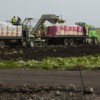Abstract
Lettuce is an economically important winter vegetable crop in Florida, with approximately 11,000 acres in production and a farm gate value of $40–$50 million annually. Florida lettuce production occurs mainly in the Everglades Agricultural Area (EAA). In recent years, research scientists at the University of Florida conducted variety trials that included the major cultivars of romaine and iceberg types. These trials were conducted on organic soil in the Everglades Agricultural Area and the IFAS-recommended practice was followed. This 3-page fact sheet describes lettuce cultivars suitable for production on organic soils in the EAA of southern Florida. Written by Huangjun Lu, and published by the UF Department of Horticultural Sciences, October 2013.
References
Dittmar, P., and W. Stall. 2013. Weed Management in Leafy Greens (Lettuce, Endive, Escarole, and Spinach). HS203. Gainesville: University of Florida Institute of Food and Agricultural Sciences. http://edis.ifas.ufl.edu/wg031
Guzman, V. L. 1984. ‘South Bay’ and ‘Raleigh’, Two Crisphead Lettuce Cultivars Resistant to Corky Root Rot for Organic Soils. Circ. S-310. Gainesville: University of Florida Institute of Food and Agricultural Sciences.
Guzman, V. L. 1986. ‘Short Guzmaine’, ‘Tall Guzmaine’, and ‘Floriglade’, Three Cos Lettuce Cultivars Resistant to Lettuce Mosaic Virus. Circ. S-326. Gainesville: University of Florida Institute of Food and Agricultural Sciences.
Hochmuth, G., Ed. Hanlon, R. Nagata, G. Snyder, and T. Schueneman. 2009. Fertilization Recommendations for Crisphead Lettuce Grown on Organic Soils in Florida. SP153. Gainesville: University of Florida Institute of Food and Agricultural Sciences. http://edis.ifas.ufl.edu/wq114
Hochmuth, G., E. Hanlon, G. Snyder, R. Nagata, and T. Schueneman. 2012. Fertilization of Sweet Corn, Celery, Romaine, Escarole, Endive, and Radish on Organic Soils in Florida. BUL313. Gainesville: University of Florida Institute of Food and Agricultural Sciences. http://edis.ifas.ufl.edu/cv008
Lu, H., A. Wright, and D. Sui. 2011. “Responses of Lettuce Cultivars to Insect Pests in Southern Florida.” HortTechnology 21(6): 773–778.
Lu, H., and D. Sui. 2012. Field performance of lettuce cultivars used in southern Florida. 2012 FSHS Proceedings 125:137-138.
Mossler, M.A., and E. Dunn. 2011. Florida Crop/Pest Management Profile: Lettuce. CIR1460. Gainesville: University of Florida Institute of Food and Agricultural Sciences. http://edis.ifas.ufl.edu/pi070
Nuessly, G.S., and S. E. Webb. 2010. Insect Management for Leafy Vegetables. ENY-475. Gainesville: University of Florida Institute of Food and Agricultural Sciences. http://edis.ifas.ufl.edu/ig161
Raid, R. N. 2004. Lettuce Diseases and their Management. Diseases of Fruits and Vegetables. 121-147.
SAS Institute. 2010. Cary, NC. http://www.sas.com.
Unless otherwise specified, articles published in the EDIS journal after January 1, 2024 are licensed under a Creative Commons Attribution-NonCommercial-NoDerivs 4.0 International (CC BY-NC-ND 4.0) license.

